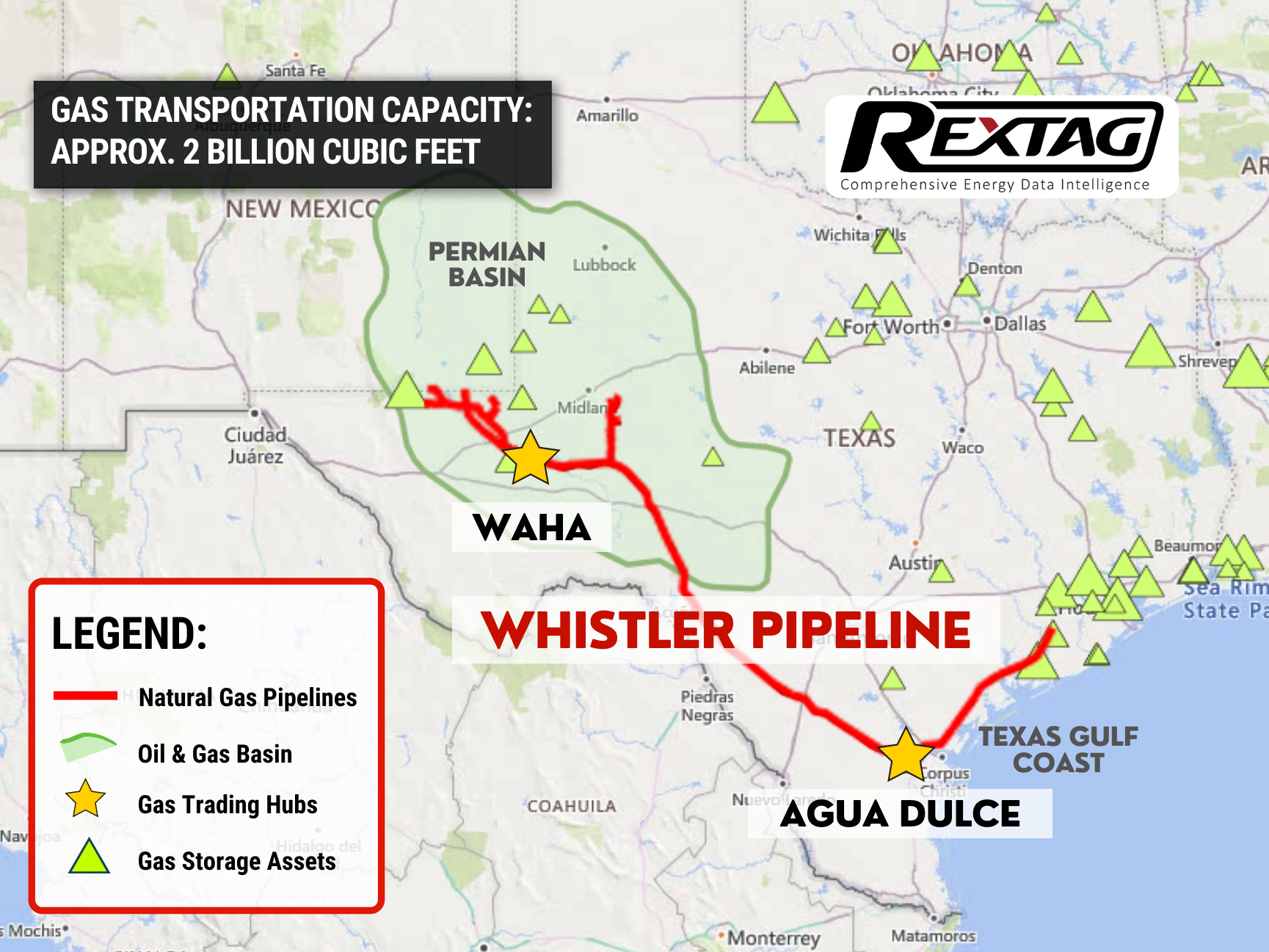Comprehensive Energy Data Intelligence
Information About Energy Companies, Their Assets, Market Deals, Industry Documents and More...
Whistler Pipeline – Acquisition And Service
09/21/2021
On July 1st 2021, the Whistler Pipeline (Austin, Texas) started its commercial service and according to a statement from the consortium which owns the pipeline, it will be adding an additional gas transportation capacity of approx. 2 billion cubic feet of incremental natural gas from the Permian Basin to the Texas Gulf Coast markets.
The Whistler pipeline is a joint venture which is owned by:
- WhiteWater Midstream MPLX
- Ridgemont Equity Partners
- As well as a joint venture between the affiliates of West Texas Gas Inc. and Stonepeak Infrastructure Partners
It is worth mentioning here that the Whistler pipeline is still 100% owned by Whistler Pipeline LLC and the aforementioned ventures signify the consortium makeup of the Whistler Group itself and its joint venture with infrastructure and supply partners.
The Whistler pipeline is of additional importance to WhiteWater after their acquisition of Waha gas storage assets that are located in West Texas, near the gas trading hub from Enstor Gas LLC. Enstor is among the USA’s largest, independent, and most geographically diverse gas storage operators that are headquartered in Houston. It has its eight storage facilities spread strategically across the five states along with facilities in Canada and Alberta. This asset will provide storage facilities to the customers of Whistler Pipelines as they are connected to Agua Blanca’s Waha header system.
The pipeline’s operation will reduce natural gas flaring in the Permian Basin along with providing sufficient and reliable gas takeaway because of which, the delivery points in the Agua Dulce will be able to provide the shippers access to the industrial and export markets of the Gulf Coast. This also includes LNG, which is a big plus. The prospects are still developing and complete applications are yet to be decided.
WhiteWater, the Austin, Texas-based midstream company operates both, Whistler and Agua Blanca. It is also partnered with multiple private equity funds, some of which include names like:
- Ridgemont Equity Partners
- Denham Capital Management
- First Infrastructure Capital
- Ontario Power Generation Inc. Pension Plan
The stats of Whistler’s pipeline include an approximate length of around 450-miles with a 42-inch intrastate pipeline, which will ensure sufficient supply for a multitude of applications such as the provision to local private customers and export. This will be transporting natural gas from the Waha Header in the Permian Basin to Agua Dulce, Texas. This, in turn, will provide the gas direct access to export markets and South Texas. Additional connectivity to the Midland Basin is ensured by the 50-mile 36-inch (approx..) lateral. Whistler pipeline now remains operational and at its peak capacity to ensure regular and effective provision of 2 billion cubic feet of incremental natural gas from the Permian Basin to the Texas Gulf Coast markets.
If you are looking for more information about energy companies, their assets, and energy deals, please, contact our sales office mapping@hartenergy.com, Tel. 619-349-4970 or SCHEDULE A DEMO to learn how Rextag can help you leverage energy data for your business.
Dallas-Based Sunoco Buys NuStar Energy for $7.3 Billion
![$data['article']['post_image_alt']](https://images2.rextag.com/public/blog/Dallas-Based Sunoco Buys NuStar Energy for $7.3 Billion.png)
Sunoco, a gas station company based in Dallas, will buy NuStar Energy, a major operator of liquid storage and pipelines, for $7.3 billion. The acquisition of NuStar Energy by Sunoco not only enlarges Sunoco's fuel distribution business but also moves it into the crude oil middle market, especially in the important Permian Basin area.
Occidental, CrownRock Merger Under Regulatory Review: 2024 Update
![$data['article']['post_image_alt']](https://images2.rextag.com/public/blog/R 228 (Blog)- Occidental, CrownRock Merger Under Regulatory Review_ 2024 Update.png)
CrownRock's 94,000+ net acres acquisition complements Occidental's Midland Basin operations, valued at $12.0 billion. This expansion enhances Occidental's Midland Basin-scale and upgrades its Permian Basin portfolio with ready-to-develop, low-cost assets. The deal is set to add around 170 thousand barrels of oil equivalent per day in 2024, with high-margin, sustainable production.
![$data['article']['post_image_alt']](https://images2.rextag.com/public/blog/328_Blog_Why Are Oil Giants Backing Away from Green Energy Exxon Mobil, BP, Shell and more .jpg)
As world leaders gather at the COP29 climate summit, a surprising trend is emerging: some of the biggest oil companies are scaling back their renewable energy efforts. Why? The answer is simple—profits. Fossil fuels deliver higher returns than renewables, reshaping priorities across the energy industry.
![$data['article']['post_image_alt']](https://images2.rextag.com/public/blog/327_Blog_Oil Market Outlook A Year of Growth but Slower Than Before.jpg)
The global oil market is full of potential but also fraught with challenges. Demand and production are climbing to impressive levels, yet prices remain surprisingly low. What’s driving these mixed signals, and what role does the U.S. play?
![$data['article']['post_image_alt']](https://images2.rextag.com/public/blog/326_Blog_USA Estimated Annual Rail CO2 Emissions 2035.jpg)
Shell overturned a landmark court order demanding it cut emissions by nearly half. Is this a victory for Big Oil or just a delay in the climate accountability movement?